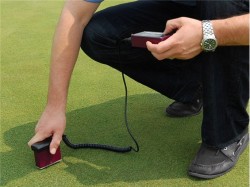5 common mistakes when measuring soil moisture

Soil moisture, or soil volumetric water content, is easily measured with probes, sensors or handheld meters. These meters are as simple as pushing the probe or sensor into the soil, pressing read on the handheld meter, and you're done. As easy as this appears, there are surprisingly many pitfalls and traps that can lead to wrong interpretation of the measured reading. Here, we outline 5 of the most common mistakes that are made when measuring soil moisture.
1. measurements are made in air
Accidentally performing a measurement when the probe, sensor or rods are in the air is quite common. Obviously, taking a reading completely in air, away from the soil, will not provide very accurate measurements! However, the less obvious and bigger problem is when the sensor is not completely in contact with the soil.
Many new users, in particular, are not aware that for most soil moisture sensors the measured value is the average over the entire surface of the sensors or rods. Even a few millimetres of the sensor not in contact with the soil can lead to drier than expected values. Unexpected air pockets deeper in the soil profile, for example caused by dislodging a stone, are particularly difficult problem to overcome.
Solution: always ensure that your sensors are in complete contact with the soil you are measuring.
2. factory calibration and your soil type
All sensors and meters have their own default factory calibration. This calibrated value could be an average from many different soil types or of a specific soil type, such as a sandy loam. In all likelihood, the calibrated value in your sensor or meter will not match the soil you want to measure. For growers, this may not be such an issue if you are only interested in full and refill points. But for researchers who need precision for experiments and modelling, the calibration value of your measurements is critical.
Solution: researchers should always calibrate sensors for each type of soil that you are measuring. Some researchers even go as far as calibrating every sensor for every type of soil they are measuring.
3. VWC, RWC, PAW, RAW and ε
Soil moisture probes, sensors and meters can have different output values that may include volumetric soil water content (VWC), soil relative water content (RWC), plant available water (PAW), dielectric permittivity (ε), or raw values such as a count or millivolt value (RAW). Most sensors and meters are set in a default mode of VWC but it may be set in a different output especially in cheaper models. The value of your output could dramatically change your interpretation of your soil moisture values.
Solution: always double check the measurement units of your output value. Do not assume your sensors and meters are all set to the same output.
4. temperature can affect your measurements
This is a lesser known cause of error in soil moisture measurements that even some experienced field operators are not aware of. The cause of this error derives from the fact that most affordable soil moisture sensors, such as capacitance or TDR type soil moisture sensors, measure the dielectric permittivity of the soil. The dielectric permittivity changes with temperature. Therefore, you may have a different soil moisture value at 4am compared with midday not because the actual soil moisture has changed, rather the temperature has changed.
Temperature variations can be easily spotted when data is continuously recorded on a data logger. If the soil moisture shows an increase during the day (and there has been no rainfall or irrigation), and there is a correlation with soil or air temperature, then your soil moisture readings are co-varying with temperature.
Temperature variations are particularly problematic with cheaper models of soil sensors and meters. This is one reason (but not the only reason) why a scientist must spend many hundreds of dollars on sensors and a gardener can do with a cheap sensor from the local hardware store. Some portable, handheld meters require daily calibration, or "zeroing", for relatively accurate measurements. For these meters, it is important to recalibrate the meter every time the temperature changes by a few degrees. The portable meters that we offer at Edaphic Scientific do not suffer from this effect and do not need recalibrating.
Solution: Good quality sensors, meters and data loggers will not have too many issues with temperature variations. Always double check your data, though, by correlating soil moisture with temperature. If you do have a co-varying temperature effect, there are complex multivariate statistical models that can correct the data. Contact us for more details.
5. salinity and electrical conductivity
Salinity, or soil electrical conductivity (EC), can also have an impact on the accuracy and measurement performance of soil moisture sensors. Similar to temperature effects, EC has an effect on how sensors measure the dielectric permittivity of the soil. Most manufacturers of soil moisture sensors indicate the range of tolerance for EC measurements. For example, the portable meters Edaphic Scientific provide are accurate in soils up to 2 mS/cm. This covers the vast majority of plant species tolerance to saline soils. So if your measurements are in soil for plant growth, horticulture, viticulture, or agriculture, this range of tolerance is sufficient.
Solution: Edaphic Scientific provides low cost, soil EC sensors so you can check the EC of your soil prior to measurements.
related articles
